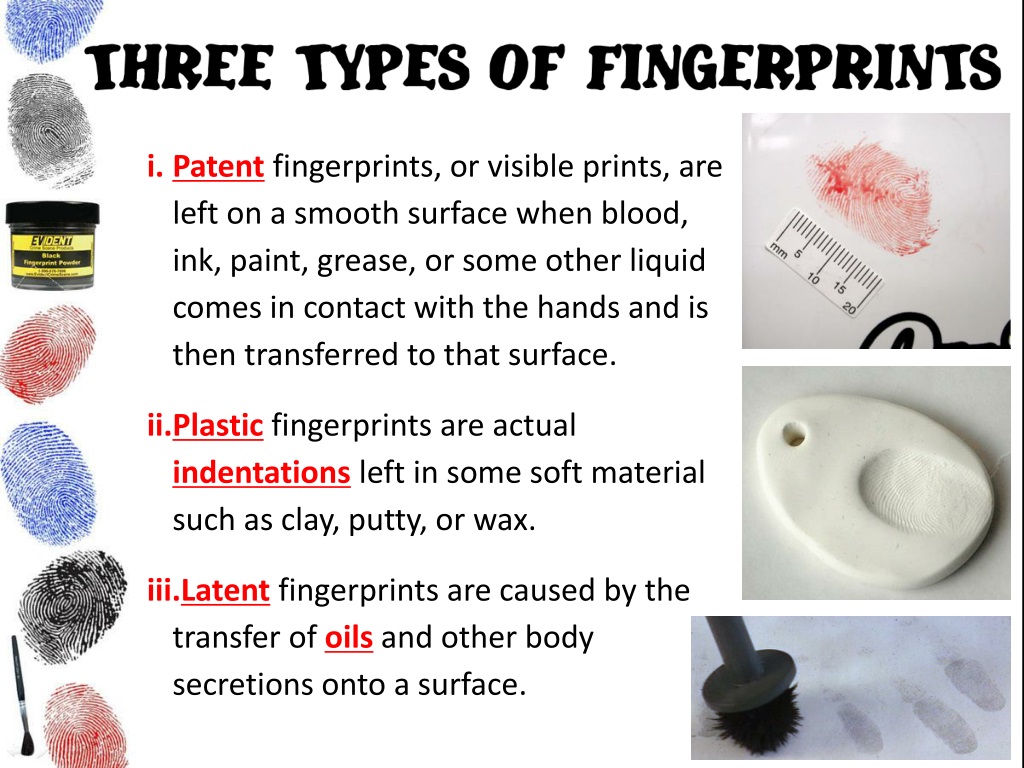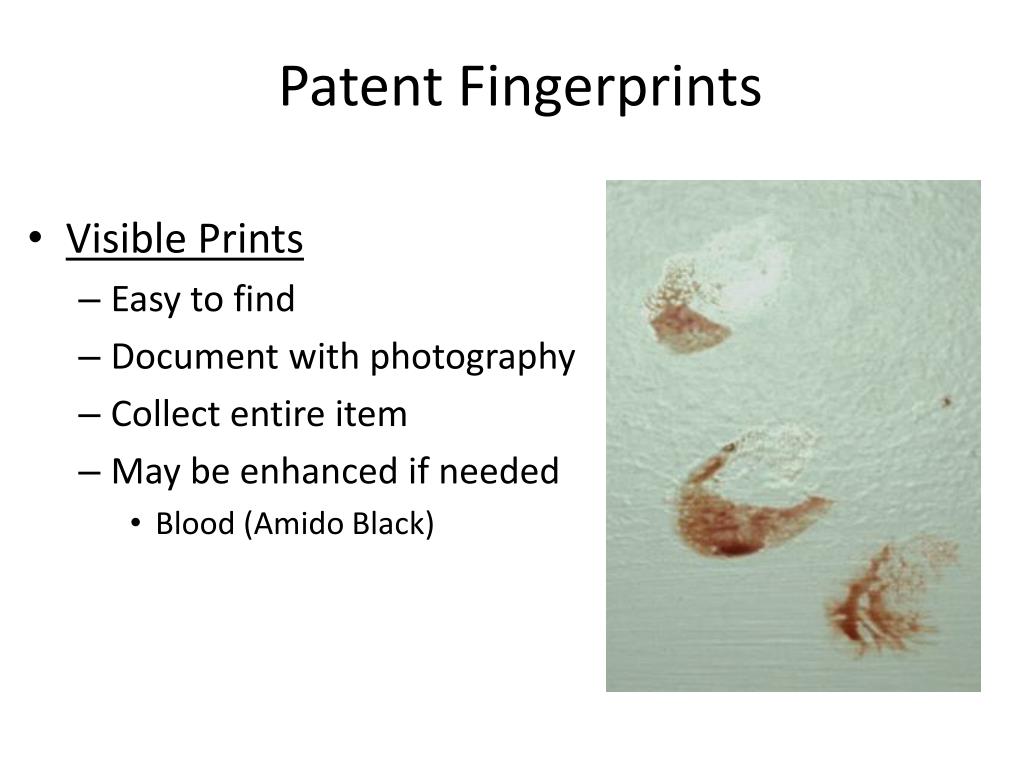Patent Fingerprints: Definition, Types & How They Are Found
Ever wondered how a simple touch can reveal a wealth of information, sometimes even solving the most complex mysteries? Fingerprints, those unique patterns on our fingertips, are not just identifiers; they are silent witnesses that can unlock the secrets hidden within a crime scene.
Forensic science, the application of scientific methods to investigate crimes, has long relied on fingerprints as a cornerstone of identification. Examiners categorize fingerprints found at crime scenes into three main types: patent, latent, and plastic impressions. These impressions, when carefully analyzed, can provide crucial evidence, helping investigators link suspects to the scene, or exonerate the innocent. The study of fingerprints is known as dactyloscopy.
| Category | Details | Examples |
|---|---|---|
| Patent Fingerprints | Visible prints, easily seen by the naked eye, formed when a finger comes into contact with a substance. | Blood, ink, paint, grease, dirt |
| Latent Fingerprints | Invisible prints, requiring special techniques like dusting or chemical processing to reveal. | Sweat, natural oils, and other invisible residues. |
| Plastic Fingerprints | Three-dimensional impressions left in a soft material. | Soap, clay, putty |
Patent fingerprints, also known as visible fingerprints, are the easiest to identify. These are the prints that are readily apparent, requiring no special techniques or enhancements to be seen. They leave a distinct ridge impression. They are essentially a visible image of a person's fingertip left on a surface. They are the most straightforward type of fingerprint to analyze, as the ridges and patterns are clearly visible.
- Who Is Tamron Halls Husband Get The Details On Steve Greener
- Thomas Massies Wife Rhondas Death Details Reactions
These visible prints are formed when a finger, already coated with a substance like blood, ink, grease, dirt, or paint, comes into contact with a surface. When someone gets arrested, police often use ink to capture that persons fingerprintsanother example of patent prints. Consider the imprint left when a muddy hand touches a wall, or the smudge of ink from a pen on a document. These are all examples of patent fingerprints.
Forensic scientists, while understanding the broader spectrum of fingerprint types, often focus on patent prints as critical evidence. Even partial fingerprints that are easily visible at a crime scene are categorized as patent prints. The readily apparent nature of these prints makes them an invaluable resource for investigators.
The permanence of a patent fingerprint varies. The surface material and environmental conditions affect how long these marks last. Blood, for example, might degrade quickly, while ink or paint could remain for a considerable time. The longevity of a fingerprint, whether patent or latent, depends on the surface it is on and the environmental conditions.
- Curb Stomp Definition Risks Examples Warning Graphic Content
- Tom Green Engaged What We Know About His New Partner Amanda
Beyond patent fingerprints, there are other types, each with unique characteristics and uses. A plastic fingerprint, for instance, results when a finger presses into a soft material, such as clay, putty, or soap. These are also easily seen, requiring no additional processing.
| Aspect | Details |
|---|---|
| Formation | Patent prints are formed when the patterned ridges of ones fingertips make a direct impression on the surface they touch, or the residue on the finger transfers to the touched surface. |
| Visibility | Patent fingerprints are immediately recognizable and do not require enhancement techniques for visibility. |
| Substances | Common substances that create patent fingerprints include blood, grease, ink, dirt, paint, or other liquids. |
| Examples | Fingerprints left in blood at a crime scene, fingerprints from ink on a document, prints left by a greasy hand. |
Latent fingerprints, in contrast, are invisible to the naked eye. These prints are formed when the natural oils and sweat on the skin are transferred to a surface. Detecting and visualizing latent prints requires specialized methods. Techniques like dusting with fingerprint powder, which adheres to the oils, or chemical treatments, which react with the sweat, are employed to make these fingerprints visible.
Forensic investigators often use various methods and tools. Powders, selected based on the surface material, are a staple in fingerprint investigation, creating a contrast that makes the prints visible. For porous surfaces like paper, chemical treatments, such as ninhydrin, are often used. These substances react with the amino acids in sweat, causing the fingerprint to become visible.
The process of finding and analyzing fingerprints involves a methodical approach. Investigators begin by carefully examining a crime scene, looking for areas likely to contain fingerprints. They use appropriate methods to develop the prints. Once found, they are photographed, lifted, and sent to a lab for analysis. These steps are essential for preserving the evidence and ensuring it can be used in court.
The collection of fingerprints isnt limited to crime scenes. Modern fingerprint technology uses a variety of techniques. In automated fingerprint identification systems (AFIS), digital scans of fingerprints are stored and compared to a database of known prints. This technology has revolutionized how fingerprints are used in investigations, making identification faster and more efficient.
Advanced fingerprinting systems are also used in many everyday applications. From unlocking smartphones to accessing secure facilities, fingerprints are a reliable form of biometric identification. These systems often employ techniques that automatically adjust the image quality to provide a clear and accurate fingerprint image.
| Category | Technique | Application |
|---|---|---|
| Dusting | Applying fine powders to surfaces. | Common on non-porous surfaces like glass and metal. |
| Chemical Treatments | Reacting with fingerprint residue | Essential for porous surfaces like paper. |
| AFIS | Digitally scanning, storing, and comparing fingerprints. | Critical for matching fingerprints against large databases. |
| Biometric Scanners | Capturing fingerprint images | For user identification, access control, and security. |
In the world of forensic science, fingerprints are more than just a visual aid; they are irrefutable evidence. They are the cornerstone of investigations, providing an invaluable means of identification and helping to bring criminals to justice. The continued advancement of fingerprinting technology, from enhancing methods to automated systems, ensures its role in modern forensic science remains vital.
- Who Is Angelica Zachary Facts Info You Need To Know
- Thomas Massies Wife Rhondas Death Details Reactions

PPT Unveiling Fingerprints The Science of Dactylography PowerPoint

Patent EP2174261B1 Fingerprint matching method and apparatus Google

Patent Fingerprints Examples